Abstract
This paper presents a circularly polarized (CP) antenna based on crossed dipoles with bandpass-type filtering radiation response. The antenna employs a pair of crossed dipole arms as radiators, which are printed on the upper and lower planes of the substrate. To achieve bandpass filtering effects, radiation nulls are introduced on both sides of the passband. By vertically extending the ends of the four dipole arms, a ring-shaped current is formed between adjacent dipoles, generating the upper-band radiation null. Additionally, four parasitic patches are introduced parallel to the ends of the crossed dipole arms, creating another upper-band radiation null, further enhancing the frequency selectivity at the band edges and broadening the axial ratio (AR) bandwidth. Moreover, a square-ring slot is etched on the ground plane to introduce a lower-band radiation null, ultimately achieving a good bandpass filtering response. The proposed wideband CP filtering dipole antenna is implemented and tested. The antenna has a compact size of 0.49 0.49 0.16 (where denotes the wavelength corresponding to the lowest operating frequency). The measured results show that the proposed antenna has an impedance bandwidth of 75% (1.65–3.66 GHz) and an overlapping AR bandwidth of 46.9% (2.25–3.63 GHz). Without additional filtering circuits, the antenna exhibits a stable gain of approximately 7 dB and three radiation nulls, with suppression levels of 20 dB in both the lower and upper stopbands, achieving good bandpass filtering performance.
1. Introduction
With the development of wireless communication technologies, various wireless communication systems are demanding increasingly higher data and capacity rates. Filtering antennas can reduce the insertion loss caused by filters and connecting lines in communication systems. CP antennas possess unique advantages such as reducing polarization mismatch, suppressing multipath interference, and mitigating Faraday rotation effects. CP antennas have been widely applied in communication system transceivers, including Global Positioning Systems (GPS), satellite communications, and wireless local area networks (WLAN).
In recent years, an increasing number of antenna researchers have devoted their efforts to studying high-performance CP filtering antennas [1,2,3,4,5,6,7,8,9,10,11,12,13,14,15,16,17,18,19,20]. Common methods for achieving CP filtering include using filtering feed networks to excite CP antennas [1,2,3,4] or employing filtering phase shifters as feed networks to drive linearly polarized antennas [5,6,7,8,9]. For example, some designs have integrated both phase shifters and filters in the feed network [5], utilized phased feed networks to excite dual-element linearly polarized filtering antenna arrays [6], and implemented filtering phase-shifting feed networks loaded with radiating patches to achieve CP filtering functionality [7,8,9]. However, these approaches based on the feed network introduce additional losses and increase the size of the antenna. Alternatively, stacked structures can be used to introduce radiation nulls and broaden the operating bandwidth. Reference [10] employed stacked patch structures with U-shaped slots to realize CP filtering effects, while Refs. [11,12] both used stacked patches with etched slots to achieve high-performance CP filtering antennas. Although the stacked patch approach can achieve good broadband CP filtering performance, it increases the antenna’s profile height and overall size, thereby limiting its application scenarios. Specifically, the antenna in [13] utilized a stacked patch structure with a crossed slot to implement CP filtering functionality, and [14] achieved CP filtering by loading a phase feed network with stacked patch structures. Other approaches include: loading filtering structures onto CP antennas [15,16], realizing CP filtering effects using metasurfaces [17], lens antennas integrated with CP radiators [18], separately exciting two orthogonal resonators to achieve CP filtering [19], and [20] implementation of a good bandpass CP antenna using crossed dipoles loaded with two square-ring patches. However, the AR bandwidths achieved by these CP filtering antennas remain relatively narrow.
This paper presents a wideband CP filtering antenna design based on a conventional single-fed CP dipole radiator with direct coaxial feeding. To achieve enhanced frequency selectivity, four parasitic patches are introduced—extending vertically from the ends of the four crossed dipole arms and aligned parallel to the arm terminals—thereby generating two radiation nulls in the upper band. Additionally, a square-ring slot etched into the ground plane creates a third radiation null in the lower band. Ultimately, the proposed antenna achieves a 46.9% axial ratio bandwidth. Without requiring any additional feeding network, it delivers a stable in-band gain of 7 dB with three radiation nulls. The design exhibits stopband suppression levels achieves 20 dB for both lower and upper stopbands, demonstrating good bandpass filtering performance.
2. Antenna Design
2.1. Antenna Configuration
Figure 1 illustrates the proposed wideband CP filtering crossed-dipole antenna. The structure comprises two dielectric substrates, including a reflector layer and a dipole antenna radiating layer. Both substrates employ Rogers (Chandler, AZ, USA) RO4003 (, ). Figure 1b,c depict the upper and lower surfaces of the dipole antenna layer, respectively. It can be observed that both the upper and lower surfaces of the dipole antenna layer are printed with one arm of the cross dipoles aligned along the x- and y-directions, which are interconnected through a quarter-wavelength delay line. The coaxial inner conductor is connected to the x-oriented printed on the upper surface dipole arm. Furthermore, the y-oriented printed on the upper surface dipole arm is excited at the same through the quarter-wavelength delay line. The x-oriented and the y-oriented printed on the lower surface dipole arms are then connected to the coaxial outer conductor. Therefore, the dipole along the x-direction has a 90° phase lead over the dipole along the y-direction, achieving left-handed circular polarization (LHCP) performance. As illustrated in Figure 1b,c, to realize the filtering performance, the ends of the four dipole arms are vertically extended. This configuration induces loop currents between adjacent dipoles, generating a radiation null in the upper band. To broaden the axial ratio bandwidth, four parasitic patches are introduced parallel to the dipole arm ends. These patches not only create an additional radiation null in the upper band, but also enhance frequency selectivity at band edges while extending the axial ratio bandwidth. Furthermore, Figure 1d shows a square-ring slot etched in the ground plane to introduce a radiation null in the lower band. The optimized parameters are presented in Figure 1. This structure ultimately realizes a wideband circularly polarized (CP) antenna with integrated filtering radiation performance. Based on this structure, a wideband CP antenna with filtering radiation performance is realized.
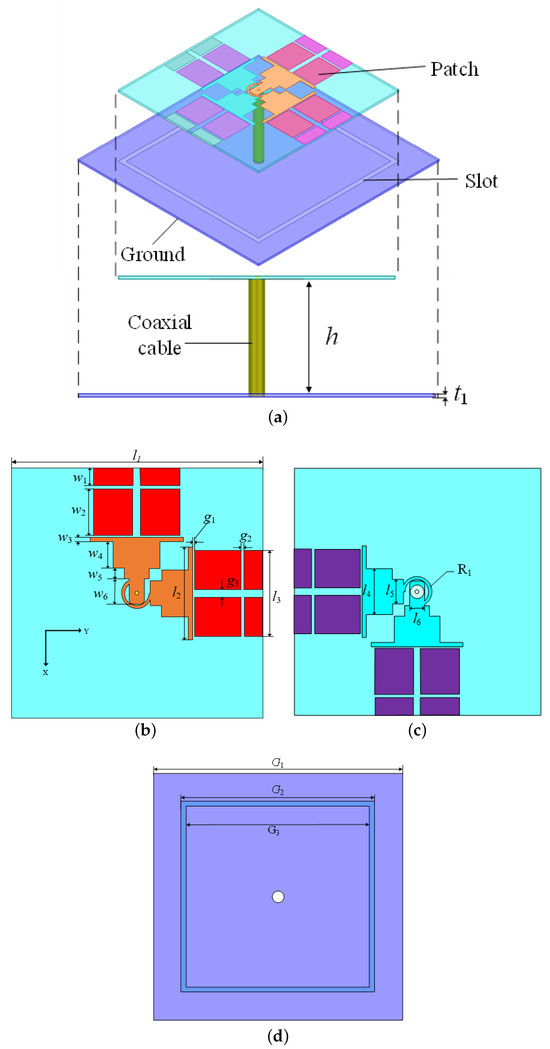
Figure 1.
Antenna structure. (a) Total view. (b) Dipole antenna layer top side. (c) Dipole antenna layer bottom side. (d) Ground plane ().
2.2. Step-by-Step Design Process
Figure 2 presents four reference antennas along with their corresponding parametric results to illustrate the operating principle of the proposed filtering CP antenna. The design originates from a classical LHCP dipole antenna structure, while incorporating tapered elements on the dipole arms. When vertically extending the ends of the four crossed-dipole arms, a CP radiation frequency at approximately 3.75 GHz is introduced, achieving a 27% AR bandwidth (AR < 3 dB). As shown in Figure 2a, a radiation null are observed in the LHCP realized gain at 5 GHz. The upper band radiation null results from loop currents formed between adjacent dipole arms. To further enhance filtering performance, two parasitic patches are introduced parallel to the dipole arm ends. This configuration creates an additional radiation null in the upper band while introducing another CP radiation frequency around 2.7 GHz. These modifications improve both the frequency selectivity at band edges and AR bandwidth expansion. Figure 2b demonstrates that reference Ant.II achieves an expanded AR bandwidth of 40% (covering 2.43–3.58 GHz with AR < 3 dB). Moreover, the enhanced current cancellation through rectangular patch coupling generates a distinct radiation null at 4.2 GHz. By incorporating four pairs of small rectangular patches coupled to the main rectangular patch, the AR bandwidth is further expanded. As shown in Figure 2c, reference Ant.III achieves an enhanced AR bandwidth of 47% (covering 2.25–3.63 GHz with AR < 3 dB). At this stage, the LHCP gain exhibits good filtering radiation performance. To achieve a tunable radiation null in the lower band, a square-ring slot is etched on the ground plane of Ant.III, as illustrated in Figure 2d. This modification introduces a radiation null at approximately 1.2 GHz while maintaining the bandpass radiation response. Notably, the square-ring slot implementation preserves the AR bandwidth without degradation, and the LHCP gain remains stable.
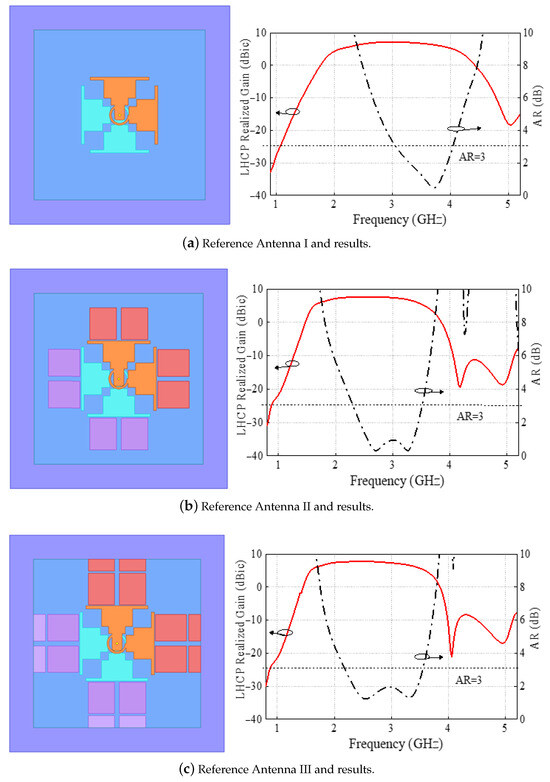
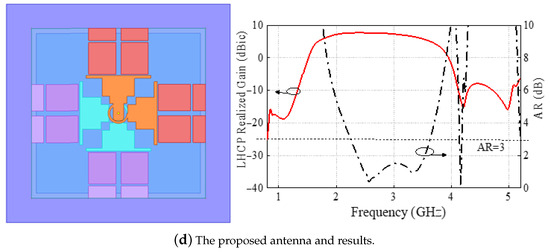
Figure 2.
Structure and results of four antennas.
Seen from Figure 3, the working frequency of reference Ant.I covers 2.5–4.5 GHz. In contrast, reference Ant.II to reference Ant.IV, with the incorporation of parasitic elements, shift their operational band to 1.6–3.7 GHz while simultaneously achieving extended impedance bandwidth.
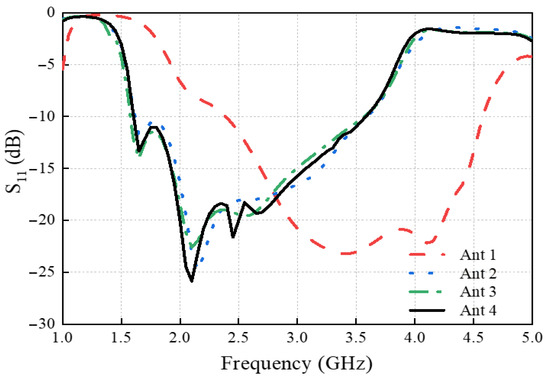
Figure 3.
The reflection coefficients of the four reference antennas.
Figure 4 presents the current distributions at the CP radiation frequency of 2.5 GHz and 3.4 GHz at t = 0 and t = T/4. At 2.5 GHz, the current flows leftward at t = 0 and upward at t = T/4. Similarly, at 3.4 GHz, the current direction is upward at t = 0 and rightward at t = T/4. These distinct quadrature current patterns clearly demonstrate the antenna’s LHCP operation. Notably, at 2.5 GHz, the dominant currents concentrate on the dipole arms and parasitic elements, exhibiting distinct left-handed circular polarization (LHCP) characteristics. At 3.4 GHz, the primary currents remain localized on the dipole arms while maintaining the same LHCP characteristics.
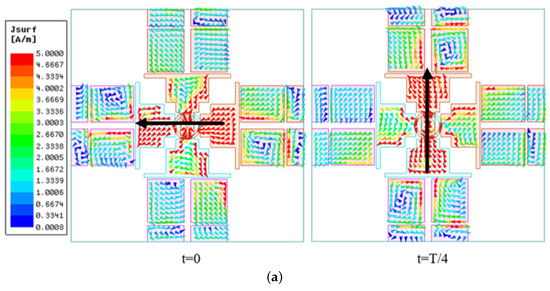
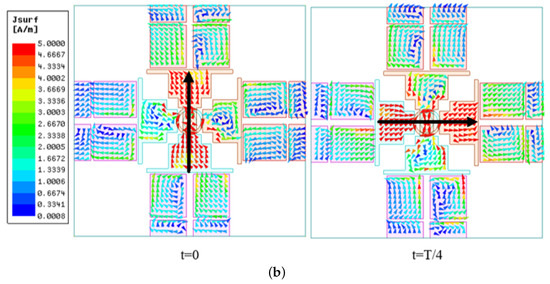
Figure 4.
Surface current distribution of the proposed antenna when t = 0 and t = T/4 at the CP radiation frequencies. (a) 2.5 GHz. (b) 3.4 GHz.
Figure 5 illustrates the parametric effects on the proposed antenna. It can be concluded that, when the length of the parasitic element () increases, the 2.5 GHz circularly polarized resonating frequency shifts toward the lower band. Similarly, extending the stepped dipole arm length () causes the 3.4 GHz circularly polarized resonating frequency shifts to the lower band with the 2.5 GHz one unchanged. These further validate the CP generation mechanism discussed in the paper.
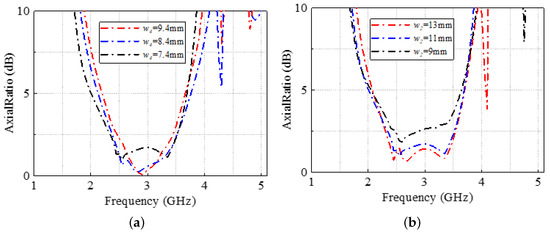
Figure 5.
Frequency control of the dual CP moods at (a) 2.5 GHz and (b) 3.4 GHz.
2.3. Analysis of Radiation Nulls
To elucidate the working mechanism of the three radiation nulls, Figure 6 illustrates the surface current distributions at these frequencies. As shown in Figure 6, at 1.1 GHz, the etched square-ring slot demonstrates carefully balanced antiparallel current distributions along its opposing edges. These equal-amplitude, yet phase-opposed currents establish a destructive interference condition that efficiently suppresses far-field radiation and a characteristic behavior of slot-line resonators where symmetric current modes mutually cancel their radiative components. The radiation null at 4.2 GHz stems from the electromagnetic interaction between adjacent parasitic patches. When these patches are excited, they generate currents with reverse phases, leading to mutual energy cancellation that effectively eliminates radiation. The higher band radiation null at 5 GHz demonstrates an interplay between the square-ring structure formed by the extended orthogonal lines adjacent to the crossed dipole arms. The geometric arrangement ensures these current systems produce opposing electromagnetic fields that interfere destructively in the far field. The radiation patterns at these radiation null frequencies are presented in Figure 7. As depicted, both right-hand circular polarization (RHCP) and left-hand circular polarization (LHCP) components remain minimal at these frequencies, indicating satisfactory radiation suppression performance. These results further confirm the non-radiative nature of these three radiation nulls. Since the lower band radiation null is introduced by the square-ring etched slot, its frequency can be adjusted by modifying the slot dimensions. In contrast, the upper band radiation null is primarily generated by the loop currents formed between the crossed dipole arms. Thus, its frequency can be tuned by altering the size of the square-loop structure enclosed by the dipole arms, as demonstrated in Figure 8. When decreases from 13.5 mm to 12.5 mm, the radiation null at 4.2 GHz shifts from 4 GHz to 4.5 GHz. When reduces from 28 mm to 24 mm, the upper band radiation null increases from approximately 4.90 GHz to 5.00 GHz, while the radiation null in the lower band remains nearly unchanged. When the length of the rectangular etched slot decreases from 70 mm to 62 mm, the radiation null shifts from 1.1 GHz to 1.25 GHz, whereas the radiation null in the upper band remains almost unaffected. These characteristics are essential for filtering antenna design. Figure 8c illustrates the parametric effects of the gap between parasitic elements on the proposed antenna. It can be concluded that, when the gap () increases, the depth of the radiation null at the higher band decreases, and vice versa. This also verifies that the higher band radiation null is generated by the reverse currents between the parasitic elements.
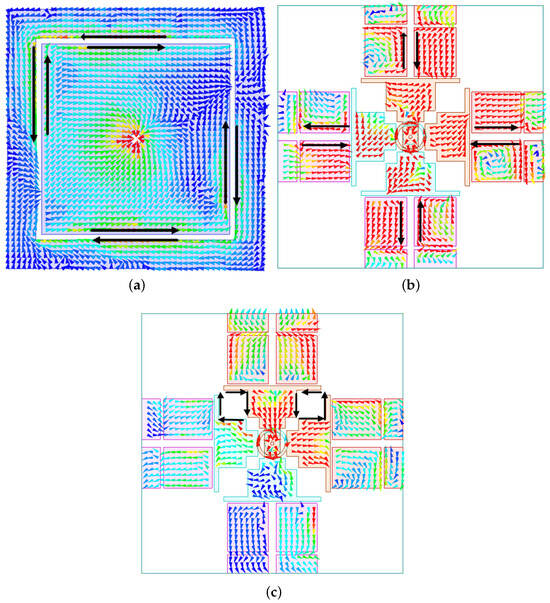
Figure 6.
Current distribution of the proposed antenna at three radiation nulls. (a) 1.1 GHz. (b) 4.2 GHz. (c) 5.0 GHz.
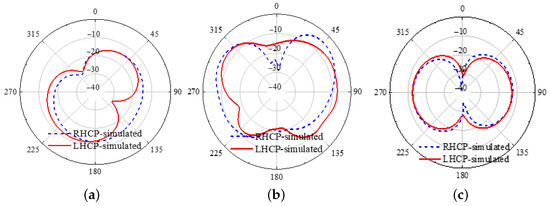
Figure 7.
Simulated radiation nulls radiation patterns at (a) 1.11 GHz, (b) 4.2 GHz, (c) 5.0 GHz.
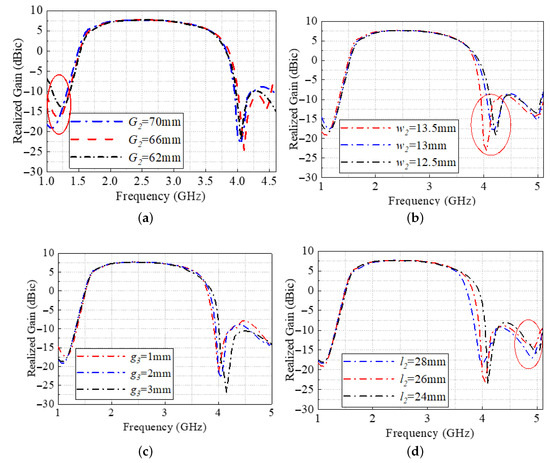
Figure 8.
Frequency control of the radiation nulls at (a) 1.1 GHz, (b) 4.20 GHz, (c) 4.20 GHz, and (d) 5.0 GHz.
3. Antenna Implementation
The proposed CP filtering dipole antenna was designed, fabricated, and measured, as shown in Figure 9a. The optimization was performed using a high-frequency structural simulator (HFSS), and the measurement was accomplished by an Agilent (Santa Clara, CA, USA) N5227A network analyzer and anechoic chamber. The results, including the S-parameters, realized gain, and axial ratio (AR), are shown in Figure 9b,c. The simulated and measured results are in good agreement, except for slight frequency shifts and reduced measured gain due to fabrication and testing tolerances.
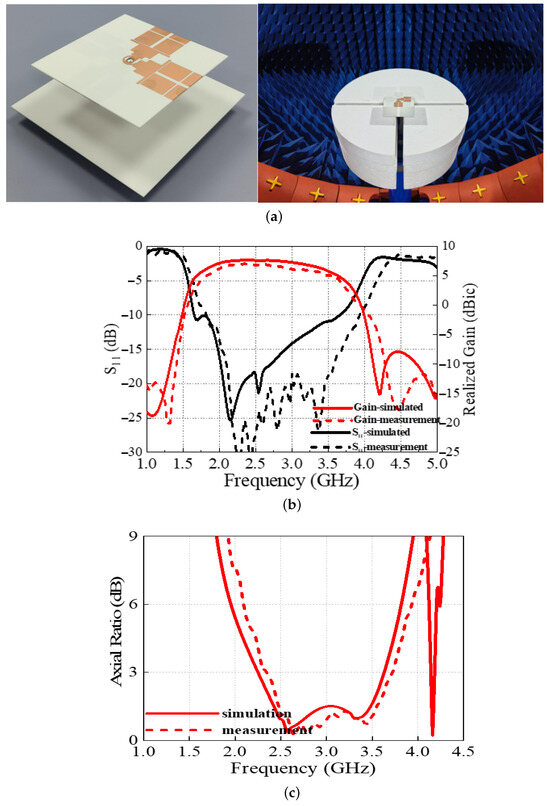
Figure 9.
(a) The proposed antenna prototype, (b) measured reflection coefficients and measured realized gains, and (c) measured AR.
Both simulated and measured (below −10 dB) cover frequency ranges of 1.65–3.66 GHz and 1.825–3.925 GHz, respectively. The antenna simulation achieves a stable LHCP gain of approximately 8 dBic, while the realized gain measures about 7 dBic. As expected, three radiation nulls are observed at approximately 1.42 GHz, 4.5 GHz, and 5 GHz, ensuring high out-of-band radiation suppression. The simulated and measured bandwidths are approximately 47% (2.25–3.63 GHz) and 46.2% (2.33–3.73 GHz), respectively. As shown in Figure 10, the antenna exhibits radiation efficiencies above 80% across the entire operating band, demonstrating good radiative performance. Figure 11 presents the normalized radiation patterns at 2.3 GHz, 3 GHz, and 3.5 GHz. As expected, stable radiation patterns with low cross-polarization levels are observed within the ±45° range. The significant power difference between the LHCP and RHCP further confirms the antenna’s effective LHCP characteristics.
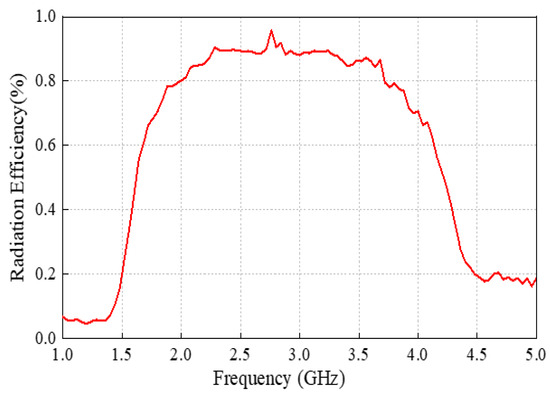
Figure 10.
The radiation efficiency of the proposed antenna.
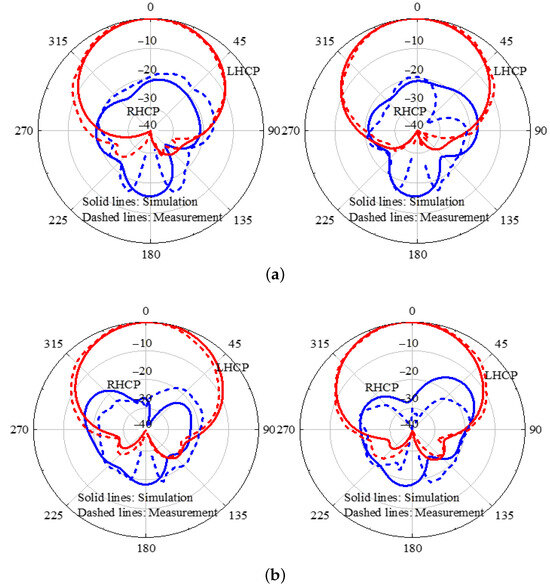
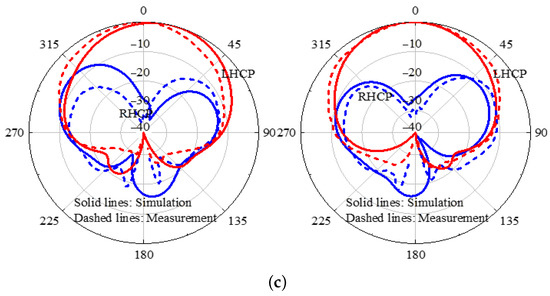
Figure 11.
Radiation patterns of the proposed antenna at (a) 2.3 GHz, phi = 0° and 90°, (b) 3 GHz, phi = 0°, and 90°, and (c) 3.5GHz, phi = 0°, and 90°.
To illustrate the advantages of the antenna designed in this study, a comparison with recent antennas is conducted, and the results are summarized in Table 1.

Table 1.
Comparison of the proposed and reported CP filtering antennas. ( denotes the wavelength corresponding to the lowest operating frequency).
In the literature [5,6,9,10,11,12,13,14,19,20], filtering CP antenna functions were implemented based on circuit structures such as filtering phase shifters [5,6,9]. While these approaches effectively achieve frequency-selective characteristics, the introduction of external filtering networks leads to insertion losses, along with limitations in axial ratio (AR) bandwidth and reduced radiation gain. In references [10,11,12,13,14], stacked patches were employed to broaden the antenna bandwidth, enhance gain, and improve out-of-band suppression levels, thereby introducing filtering radiation responses. Although the stacked-patch configuration can achieve good broadband CP filtering performance, it increases the antenna’s profile height, leading to larger overall dimensions and limiting its applicability. Additionally, the performance improvements are constrained. For instance, in [10], while CP filtering was realized, the AR bandwidth was only 15.2%, with a GSI (Gain-Suppression Index) of merely 0.73. Notably, Refs. [11,12] utilized stacked patches to achieve relatively wide AR bandwidths, but this came at the cost of increased profile height, weak out-of-band suppression, and unstable in-band gain. In [13], the stacked-patch approach achieved CP filtering but with a narrow AR bandwidth of 9.32% and poor GSI. Although Ref. [14] demonstrated high radiation gain, it still exhibited shortcomings in AR bandwidth and out-of-band suppression capability. In [20], a crossed-dipole structure was used to realize CP radiation, while two annular structures were cleverly employed to generate filtering effects. However, the AR bandwidth remained narrow, and the overall size was relatively large.
The proposed antenna exhibits a wide axial ratio (AR) bandwidth, excellent filtering performance, and stable in-band circularly polarized (CP) radiation characteristics. Moreover, it achieves a high gain stability index (GSI) of 0.888, calculated using the methodology outlined in [21].
4. Conclusions
In this paper, a wideband CP filtering crossed-dipole antenna has been proposed. By vertically extending the four arms of the crossed dipole and introducing four parasitic patches parallel to the dipole arm ends, the design has achieved a wide 3 dB axial ratio (AR) bandwidth of 46.9% (2.25–3.63 GHz) while creating two upper-band radiation nulls. A square-ring slot has been etched on the ground plane to generate an additional lower-band radiation null, collectively producing a bandpass filtering response. The high-selectivity bandpass performance has been realized through three controllable radiation nulls: the lower-band null has been primarily induced by the ground’s square-ring slot, the 4.2 GHz null has been mainly generated through mutual coupling between parasitic patches, and the 5 GHz null has been dominantly created by loop currents formed between the crossed-dipole arms. The measured results have shown good performance, with an impedance bandwidth of 73% (1.825–3.925 GHz), an AR bandwidth of 46.2% (2.33–3.73 GHz), and a stable gain of approximately 7 dB. Without additional filtering circuits, the antenna has achieved three radiation nulls, with suppression levels reaching 20 dB in both the lower and upper stopbands, thereby realizing a favorable bandpass filtering effect.
Author Contributions
Conceptualization, X.L. and R.H.; methodology, X.L. and M.Z.; software, R.H.; validation, X.L., R.H., and A.Y.; formal analysis, M.Z.; investigation, A.Y.; resources, X.L.; data curation, R.H.; writing—original draft preparation, X.L. and M.Z.; writing—review and editing, R.H. and A.Y.; visualization, M.Z.; supervision, X.L.; project administration, X.L.; funding acquisition, X.L. All authors have read and agreed to the published version of the manuscript.
Funding
This work was supported by the Guangdong-Taiwan Technology Cooperation Projects in Guangdong Province Granted No. 2024A0505050044.
Data Availability Statement
Data is contained within the article.
Conflicts of Interest
The authors declare no conflicts of interest.
References
- Zhao, Z.; Qiu, L.-F.; You, B.; Wu, L.-S.; Mao, J.-F. Three-Dimensional Integrated Circularly Polarized Filtering Antenna Array with High-Efficiency Hybrid Feeding Network. IEEE Trans. Antennas Propag. 2024, 8, 6348–6361. [Google Scholar] [CrossRef]
- Xu, H.; Liu, H.; Huang, T.; Liu, T.-Y. 3-D-Printed Dual-Band Circularly Polarized Filtering Antenna with Self-Diplexing Property for Millimeter-Wave Applications. IEEE Trans. Antennas Propag. 2024, 4, 3807–3812. [Google Scholar] [CrossRef]
- Huang, T.; Liu, H.; Xu, H.; Geng, L. Three-Dimensional Printed mm-Wave Circularly Polarized Filtering Antenna with Flexible Design and Spurious Suppression. IEEE Trans. Antennas Propag. 2023, 10, 8266–8271. [Google Scholar] [CrossRef]
- Hu, H.-T.; Chan, K.F.; Chan, C.H. 60 GHz Planar Circular-Polarized Filtering Antenna and Its Integrated Design with Folded Reflectarray. IEEE Trans. Antennas Propag. 2024, 12, 8958–8970. [Google Scholar] [CrossRef]
- Hu, Y.; Wu, Y.; Wang, G.; Wu, X. A Circularly Polarized, Highly Selective, Harmonic-Suppressed Filtering Antenna for 5G Application. IEEE Antennas Wirel. Propag. Lett. 2024, 12, 4308–4312. [Google Scholar] [CrossRef]
- Liu, S.; Wang, Z.; Dong, Y. A Compact Filtering Patch Antenna with High Suppression Level and Its CP Application. IEEE Antennas Wirel. Propag. Lett. 2023, 4, 769–773. [Google Scholar] [CrossRef]
- Paul, V.; Dhwaj, K. A Reflectionless Circularly Polarized High-Gain Microstrip Filtering Antenna with Wideband Response. IEEE Trans. Antennas Propag. 2024, 6, 5384–5389. [Google Scholar] [CrossRef]
- Li, J.-F.; Lin, Y.-Q.; Xue, Y.-M.; Ye, L.-H.; Mao, C.-X. A Shared-Aperture Linearly/Circularly Polarized Filtering Antenna Array with Low Profile. IEEE Antennas Wirel. Propag. Lett. 2024, 11, 3877–3881. [Google Scholar] [CrossRef]
- Xu, T.; Li, J.-F.; Ye, L.-H.; Wu, D.-L.; Zhang, G. A Wideband Circularly Polarized Filtering Patch Antenna with Strip Network. IEEE Antennas Wirel. Propag. Lett. 2023, 12, 2826–2830. [Google Scholar] [CrossRef]
- Cheng, G.; Huang, B.; Huang, Z.; Yang, L. A High-Gain Circularly Polarized Filtering Stacked Patch Antenna. IEEE Antennas Wirel. Propag. Lett. 2023, 5, 995–999. [Google Scholar] [CrossRef]
- Zhou, J.; Pan, X.; Cheng, G.; Yang, L.; Li, Y.; Huang, Z. A Wideband Circularly Polarized Filtering Antenna Based on Multilayer Structural Design. IEEE Antennas Wirel. Propag. Lett. 2024, 11, 3887–3891. [Google Scholar] [CrossRef]
- Wang, J.; Zhang, Y.; Ye, L.; Liu, Q.H. A Wideband Circularly Polarized Filtering Antenna Based on Slot-Patch Structure. IEEE Antennas Wirel. Propag. Lett. 2023, 11, 1858–1862. [Google Scholar] [CrossRef]
- Cheng, G.; Zhou, J.; Yang, L.; Wu, X.; Huang, Z. A Stacked Circularly Polarized Filtering Antenna with Crossed Slot. IEEE Antennas Wirel. Propag. Lett. 2023, 12, 2935–2939. [Google Scholar] [CrossRef]
- Xiao, Z.; Cao, Y.; Che, W.; Xue, Q. Millimeter-Wave Filtering Circularly Polarized Antenna Using Hybrid Radiation Modes for Satellite Applications. IEEE Trans. Antennas Propag. 2024, 10, 7584–7593. [Google Scholar] [CrossRef]
- Xiang, K.-R.; Chen, F.-C.; Xue, Q.; Chu, Q.-X. A High-Selectivity Circularly Polarized Filtering Antenna Based on Wavefront Phase Compensation. IEEE Antennas Wirel. Propag. Lett. 2024, 10, 3307–3311. [Google Scholar] [CrossRef]
- Cao, C.-F.; Li, E.S.; Jin, H.; Chen, D.; Chin, K.-S. Designs of Dual-Band Circularly-Polarized Filtering Antennas Using Multiple Resonant Modes. IEEE Access 2024, 121538–121551. [Google Scholar] [CrossRef]
- Jia, Q.; Zhang, W.; Han, X.; Huang, Y.; Ding, S.; Wang, B.; Bozzi, M. A Broadband Filtering Circularly Polarized Folded Transmitarray Antenna Based on Metasurface. IEEE Antennas Wirel. Propag. Lett. 2023, 10, 2357–2361. [Google Scholar] [CrossRef]
- Hu, H.-T.; Chan, K.F.; Chan, C.H. High-Gain Dual-Circular-Polarized Filtering Lens Antenna for Low-Cost 60 GHz Applications. IEEE Antennas Wirel. Propag. Lett. 2024, 2, 828–832. [Google Scholar] [CrossRef]
- Cahyasiwi, D.A.; Zulkifli, F.Y.; Rahardjo, E.T. Orthogonal Resonators for Circularly Polarized Filtering Antenna Using a Single Feedline. IEEE Trans. Microw. Theory Tech. 2023, 4227–4235. [Google Scholar] [CrossRef]
- Lin, X.J.; Zhang, Y.; Qiu, Z.L.; Huang, Z. A Compact Circularly Polarized Filtering Dipole Antenna with Co-Layered Printed Ring Structures. IEEE Antennas Wirel. Propag. Lett. 2024, 10, 3098–3102. [Google Scholar] [CrossRef]
- Feng, B.; Chen, J.; Chung, K.L.; Wang, L.; Li, Y. Dual-Polarized Filtering Magneto-Electric Dipole Antenna Arrays with High Radiation-Suppression Index for 5G New Radio n258 Operations. IEEE Trans. Antennas Propag. 2022, 3, 3058–3063. [Google Scholar] [CrossRef]
Disclaimer/Publisher’s Note: The statements, opinions and data contained in all publications are solely those of the individual author(s) and contributor(s) and not of MDPI and/or the editor(s). MDPI and/or the editor(s) disclaim responsibility for any injury to people or property resulting from any ideas, methods, instructions or products referred to in the content. |
© 2025 by the authors. Licensee MDPI, Basel, Switzerland. This article is an open access article distributed under the terms and conditions of the Creative Commons Attribution (CC BY) license (https://creativecommons.org/licenses/by/4.0/).